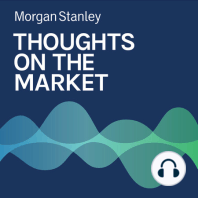4 min listen
Mike Wilson: Revisiting the 2022 Outlook
ratings:
Length:
4 minutes
Released:
Apr 4, 2022
Format:
Podcast episode
Description
With the end of the first financial quarter of 2022 the market has begun to price in some of the continuing risks to economic growth, forcing investors to reconsider the trajectory for the rest of the year.-----Transcript-----Welcome to Thoughts on the Market. I'm Mike Wilson, Chief Investment Officer and Chief U.S. Equity Strategist for Morgan Stanley. Along with my colleagues bringing you a variety of perspectives, I'll be talking about the latest trends in the financial marketplace. It's Monday, April 4th, at 11:00 a.m. in New York. So let's get after it. Given how bad first quarter returns were for both stocks and bonds, most investors were probably happy to see it end. Furthermore, the rally in the second half of March made it considerably better for stocks than it was looking just a few weeks ago. In the end, though, bond returns ranked worse than stocks from a historical perspective, with Treasuries posting the worst quarter in 50 years. The tough first quarter was very much in line with our view coming into 2022. To recall, we didn't see many fat pitches given the Fed's resolve to fight the surge in inflation in the face of slowing growth. Whether it was for technical or fundamental reasons, bond and stock markets ignored this risk into year-end. Apparently, they required a more obvious signal, which appeared on January 5th with the minutes of the Fed's December meeting. From that moment, both stocks and bonds made a sharp U-turn and never really looked back for the entire first month of the year. In short, headline indices for both stocks and bonds finally adjusted to the fire part of our narrative, a risk that started to price under the surface back in November. With inflation and the Fed the number one concern during the first quarter, it makes sense that bonds would be worse than equities. It also makes sense that stocks more vulnerable to higher interest rates underperformed. As an example, the Nasdaq performance was considerably worse than both the S&P 500 and the small cap Russell 2000, a very rare occurrence over the past few years. And this is after a major rally in the past two weeks that was led by the Nasdaq. Our conclusion is that markets were preoccupied in the first quarter with the Fed's sharp pivot, more than anything else, and it played out in asset prices appropriately. Of course, the other major driver for markets in the first quarter was the war in Ukraine. While tensions had been building since late last year, it's fair to say markets had ignored that risk, too. The only difference is that the Fed's pivot was well telegraphed, while Russia's invasion was far from a sure thing and more of an unknown known to most, including us. Obviously, such an event did materially factor into the risk for the first quarter by accentuating the fire and ice by making inflation worse whilst simultaneously dampening growth prospects. It also has rattled confidence for both businesses and consumers, especially in Europe. This was not in our calculus when we made our forecast for 2022. As such, we find ourselves incrementally more negative on growth trends than we were at the end of last year. Last fall, we pushed out the timing of the ice part of our narrative to the first half of this year, when we realized that the economy still had plenty of strength left for companies to deliver on earnings growth. But now investors face multiple headwinds to growth that will be harder to ignore. These include the payback in demand from last year's fiscal stimulus, demand destruction from higher prices, food and energy price spikes from the war that serves as a tax and inventory bills that have now caught up to demand. While the employment report for March last Monday was strong once again, the Purchasing Managers Survey for Manufacturing showed a sharp deterioration in the orders component. Relative to inventories it looks even worse, with the inventory component of the index now below orders for the first time since the recover
Released:
Apr 4, 2022
Format:
Podcast episode
Titles in the series (100)
Michael Zezas: Indirect Impacts by Thoughts on the Market
